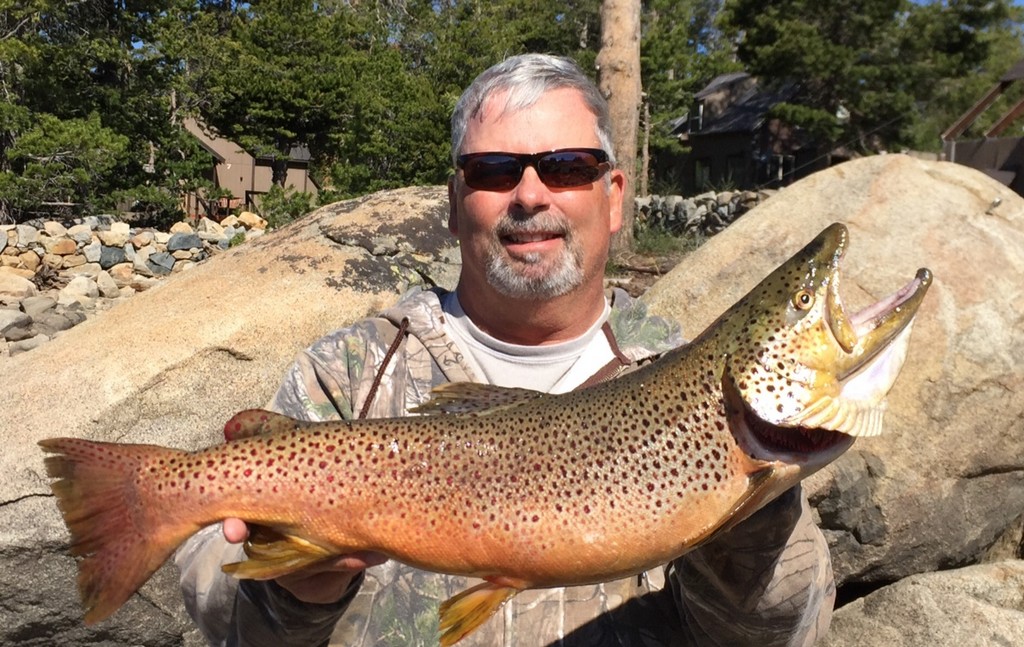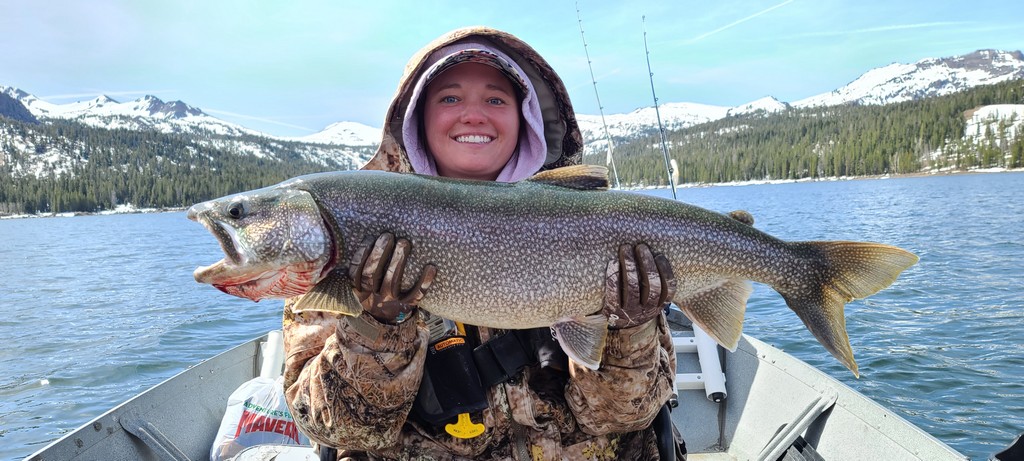Caples Lake, an El Dorado Irrigation District (EID) managed reservoir in Alpine County, offers an unbeatable combination of majestic alpine scenery and fine trophy trout fishing.
Big browns and mackinaw lurk in the clear, pristine waters of Caples. The lake mackinaw record is 26 pounds and 39 inches held by Norm Perini from Pine Grove. Jeff Walters from Kirkwood holds the brown trout record at 13 pounds and 31 inches.
Besides hosting trophy brown mackinaw trout, the lake at this time also hosts recently planted brown trout, along with rainbow trout.
Caples features 620 surface acres and is situated at approximately 7,820 feet above sea level when the lake is full. It is located off Highway 88, roughly one mile west of the Carson Spur, and about 17 miles south of Lake Tahoe.
The resorts, boat ramps and marinas are now open at Caple. Savvy trollers are catching and releasing big mackinaw trout up to 18 pounds, while shore anglers are hooking lots of recently planted brown trout. Boats are limited to 5 mph.
The California Department of Fish and Wildlife stocked the first batch of 2,000 pounds of 10- to 14-inch browns before Memorial Day weekend and the second batch of 2,000 pounds of browns on June 1, according to Joe Voss of Caples Lake Resort.
Shore anglers find solid trout action at the dam, spillway, Woods Creek inlet and other areas on the lake while tossing out PowerBait, Power Eggs, crawlers and an array of Kastmasters, Rooster Tails, Panther Martin spinners, Little Cleos, Thomas Buoyant spoons and other lures.
Boaters trolling with Flatfish and other lures have picked up some huge mackinaw to date this season. For example, Chris Hostnick landed an 18-pound mack during a trolling adventure.
Rene Dombrowski of Carson also landed several macks in the 14- to 16-pound range while trolling with her husband, Ryan, in late May.

Voss advises boaters in pursuit of rainbows and browns to top-line troll with flashers and worms. For wild browns, he urges boaters troll with Kastmasters, Speedy Shiners and stickbaits including Rapalas early in the spring and late in fall before the lake ices over.
I have fished Caples numerous times from the bank since 1999 and have done very well on a mixture of rainbow, brown and brook trout. My best trip was in 2008 on the very day that the lake was being planted again with CDFW rainbows after being drained to minimum pool for work on the dam.
Although the majority of fish were rescued in a cooperative venture between the California Sportfishing Protection Alliance and the CDFW, there were a surprising number of colorful brown, rainbow and brook trout left in the lake.
I had a blast catching one fish after another under floating debris near the dam. The fish ranged from 16 to 17 inches long. The few of us fishing at this spot before and after the plant caught easy mixed limits of all three species while tossing out nightcrawlers under water filled clear bobbers.
The CDFW over the past couple of years has planted a mixture of fingerling and cathable rainbow trout in the reservoir. The Department stocked 80,000 fingerling rainbows weighing 800 pounds and 20,000 catchable rainbows weighing 10,000 pounds in 2018. The agency also planted 20,000 catchable rainbows weighing 10,000 pounds in 2019.
Caples Lake has a long and fascinating of fish plants and creel surveys. The California Department of Fish and Wildlife has stocked Caples with trout since 1930, according to Ben Ewing, CDFW Fisheries Biologist, in a report on Caples published in April 2018.
Historically, Caples has been planted with rainbow trout (Oncorhynchus mykiss) (RT), brook trout (Salvelinus fontinalis) (BK), brown trout (Salmo trutta) (BN), and lake trout (Salvelinus namaycush) (LT).
“Currently only rainbows and browns are being stocked in Caples by CDFW and EID. Along with current and past CDFW stocking, Caples currently supports populations of non-game fish such as Lahontan redsides (Richardsonius egregius) and tui chub (Gila bicolor). There is also a self-sustaining lake trout sport fishery,” said Ewing.
Woods Creek and Emigrant Creek are the main sources of inflow to Caples. Caples drains into Caples Creek, which flows into the South Fork American River.

In order to assess the fishery, CDFW installed three angler survey boxes (ASBs) at Caples.A total of 78 anglers responded to the survey in 2016, an increase from 67 respondents in 2015. Cumulatively, these anglers reported 154 fish landed in 2016 compared to 48 in 2015. The average catch per angler and hours per angler was 1.97 and 4.0, respectively in 2016.
Average catch per angler in 2016 increased more than two-fold from 2015 (0.72), while the hours per angler in 2016 was almost identical to 2015 (3.9).
“Anglers reported using bait, lures, and flies while fishing at Caples. Five anglers (6%) used flies and had a 3.0 catch/angler average in 2016. This was the highest identifiable gear used to take fish in 2016. In 2015, the one fly angler caught no fish, which had the lowest catch per angler as well,” said Ewing.
Approximately 90% (138) and 96% (46) of fish landed were rainbows in 2016 and in 2015, correspondingly.
“Lake trout comprised approximately six percent of fish landed in 2016 and approximately four percent in 2015. Brook trout and brown trout combined to be less than five percent of the total catch in 2016. Seventy percent of the rainbow trout that were measured were less than 14.0 inches in total length in 2016, which is consistent with 2015 at 76%” Ewing stated.
Anglers reported landing seven (5% of total fish landed) fish greater than 20.0 inches in 2016, consisting of three rainbows, two lake trout and two browns. Anglers reported landing five (10% of total fish landed) fish greater than 20.0 inches, which included three RT and two LT in 2015.
Data gathered from the Caples Lake surveys indicates anglers had caught less than one fish on average per day in 2015 (0.72), but in 2016 catch per angler increased to almost two fish per day (1.97).
“The increase in catch rate and total fish caught may be due to the high number of fingerling-size RT stocked in 2014 and 2015, which have grown to catchable size. The number of respondents in 2016 was 78, an increase from 67 in 2015,” said Ewing.”
Historically, the Washoe Indian Tribe from Carson Valley would hunt, fish and forage in the summer around Caples Lake, originally known as Twin Lakes because the original meadows had two shallow lakes, approximately six feet deep.
The dam on the Northwest side and the spillway on the West side of the lake were constructed in 1922 and raised in 1952.
In 1982 the late John Voss bought the resort and in the El Niño winter of 1983 endured 800 inches of snow blowing through the walls, windows, doors and roofs, frozen pipes, broken well, burnt up power lines, blown up lodge heater, and so on. In the summer of 1983 the lake thawed on a record late July 2nd.
The Voss’s have kept the resort open every winter since 1982 except for closing in the winter of 1991 due to the drought years. For more information, contact Caples Lake Resort, (209) 258-8888, www.capleslakeresort.com.
Caples Lake Resort Facts
Location: Caples Lake Resort Is located in the historic Carson Pass Area of the Northern California Sierra on the north shoreline of the 600 acre Caples Lake at 7806′ elevation. It is 1 mile east of the Kirkwood Mountain Resort, at 1111 California State Highway 88. The resort is 30 miles from South Lake Tahoe, California, within the El Dorado National Forest, under a USFS Special Use Permit.
Features:
• 9 Cozy housekeeping Cabins overlooking Caples Lake and the High Sierra Mountains.
• A 2 story Lodge with 6 B&B Lodge Rooms, on the shore of Caples Lake.
• A Marina with boat rentals, boat launch, a bait & snacks store, and trophy trout fishing.
• Area Activities: camping, hiking, biking, boating, fishing, solitude photography.
• An unparalleled view of scenery, nature, wildflowers, & 4 seasons of colors.
• Renewable Energy – Off the Grid and Green.
Campground: The USFS Caples Lake Campground is operated across Hwy 88 by Sierra Recreation Managers.
Season: The resort is are from Memorial Day through October and from Christmas until April. Fishing is open year round for rainbow, brook, brown and mackinaw trout. Caples Lake usually freezes over by early December and becomes a playground for ice fishermen, cross country skiers, and snowshoe trekkers
Wildflowers: The volcanic ridges left behind as the glaciers receded from the Carson Pass area form a perfect habitat for wild flowers. In addition, because plant environments range from scree to open pasture and from seep to bog, a variety of species flourish. Peak bloom here is usually in mid-July, with flowers so dense and so various that a walk, even a short, easy one, can take the better part of a day. Bring your camera!
More information: Contact Caples Lake Resort by calling: (209) 258-8888 or email us: reservations@capleslakeresort.com. The website address is http://capleslakeresort.com/

